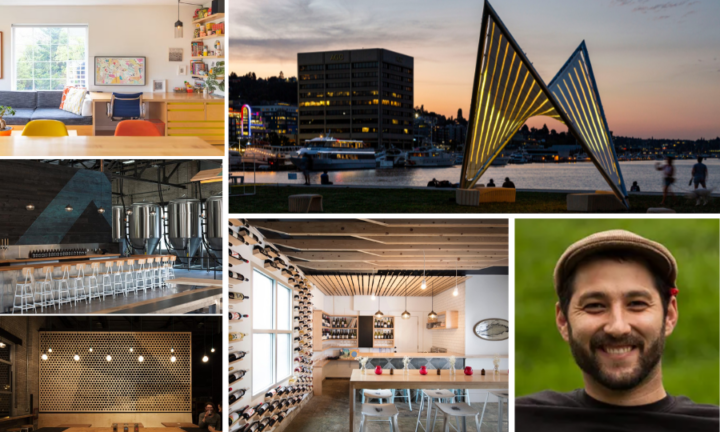LMN Architects is back this year to host the SDF Closing Party in their Pioneer Square space. In anticipation, we sat down with Hank Butitta, the Shop Manager at LMN, to learn more about his work in design.
Purchase your tickets now for the SDF Closing Party at The Shop @LMN this Thursday, August 22. Capacity is limited, so registration is required!
Hank Butitta (he/him) | Growing up in Wisconsin, I was attracted to architecture at a young age through exposure to the work of Frank Lloyd Wright, and I’ve been in pursuit of becoming a “master builder” ever since.
During my architectural education at the University of Minnesota, I recognized that my interests and skills fell somewhere between architecture and construction. I developed a passion for translating design intent into built spaces, and started spending an increasing amount of time in the shop developing analog and digital fabrication skills.
For my graduate thesis, I bought a school bus and converted it into a living space. Upon graduation I continued to pursue design through fabrication, opening a small design/build workshop, and teaching fabrication-focused studios in UMN’s BDA program.
After a few fun and challenging years of self-employment, I moved to Seattle with my partner Nell. In 2016, I joined LMN architects, in large part because of the 1,000sf workshop. In 2019, I earned my architectural license and then transitioned to the role of shop manager.
In 2023, we opened our new 6,000 sf shop, with an emphasis on design through fabrication of full-scale mockups and installations, working in close collaboration with project teams and other stakeholders.
Q&A
How do you use WHAT IF? thinking in your work?
“WHAT IF” is pervasive in my design process, but I think this is true for most people who take an interest in design. “WHAT IF” is the natural state for designers, and it is the reason we drive non-designers crazy. We’re constantly questioning, and challenging, and reinventing. This is valuable and inextricable from the design process, but I think an important part of maturing as a designer is understanding when you should use “WHAT IF” to bring the most value. You only have so much time and energy to spend, how can you best utilize that inquisitive nature to benefit your work?
Who or what inspires you?
I’m inspired by people who make things, especially of their own vision. Builders, artists, entrepreneurs, the whole gamut. I’m lucky to know many flavors of maker, and they inspire me to continue pursuing my own creative endeavors.
Tell us about a project that you completed that you are most proud of.
Because this blog is being hosted by the Seattle Design Festival, I think it would be appropriate to note that one of my proudest projects is Equipoise Pavilion, which was originally built for the 2022 SDF, and is being erected again at the 2024 SDF for use as a main stage. I’m especially proud of this project because it so cleanly and clearly achieved it’s vision to be simultaneously a place and a sculptural object. This was achieved despite the complex structural and logistical challenges of creating 20′ cantilevers balancing on just two points, with a requirement to be set up in mere hours without the aid of heavy equipment. It was a blend of various materials and fabrication processes, savvy design and engineering, clever detailing, and hard work from a dedicated and multi-faceted team.
What is your ultimate goal when it comes to your work? What do you hope to contribute?
The biggest compliments we received were from curious passersby who assumed it was a new permanent installation. For a temporary structure to have the presence of a permanent installation speaks to the great success of the project and the team, and I’m really proud of the result.
My ultimate goal as a designer is to ensure that design intent survives the construction process. Modern technology makes it so easy to design fantastic looking structures and spaces, but does little to guarantee that a design is feasible or reasonable, and it allows you ignore many inconvenient realities like structure, utilities, construction sequencing, etc.
Too often, design intent is compromised by overlooked details and unconsidered challenges. My goal is to anticipate these obstacles by leaning on my experience in both design and fabrication to help bring strong, clear design intent into reality.





